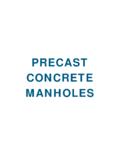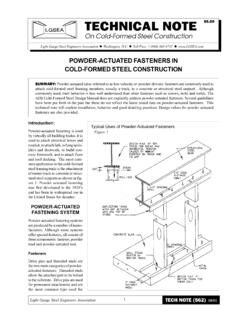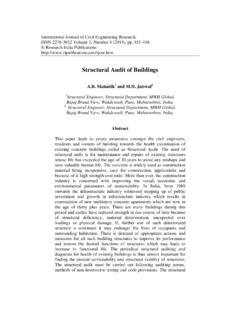Transcription of Electrical Resistivity of Concrete - Giatec Scientific Inc.
1 | Ci | MAY 2015 41 Electrical Resistivity of ConcreteConcepts, applications, and measurement techniquesby Hamed Layssi, Pouria Ghods, Aali R. Alizadeh, and Mustafa SalehiThe so-called rapid chloride permeability (RCP) test is a widely accepted approach for assessing the durability of Concrete . Originally proposed by Whiting1 and since standardized as ASTM C12022 and AASHTO T 227,3 the test method allows the measurement of the total Electrical charge passing through a Concrete specimen subjected to a standard voltage. While it does provide an indication of the Concrete s ability to resist chloride ion penetration, the RCP method is neither rapid nor capable of direct measurement of chloride permeability.
2 Rather, the test was developed by correlating a measured charge to the total chloride penetrating to a depth of 1-5/8 in. (41 mm) of reference slabs subjected to a 90-day ponding test (AASHTO T 2594). The chloride permeability categories are thus qualitative. As an alternative, Electrical Resistivity measurement can be used for the performance-based evaluation of Concrete . Resistivity test procedures, including sample preparation, are much easier and faster than that of the RCP test. Also, the Resistivity value can be directly related to the chloride diffusion coefficient of Concrete using the Nernst-Einstein Several techniques have been developed and studied for measuring the Electrical Resistivity of Concrete , including the bulk Electrical Resistivity and surface Electrical Resistivity .
3 In this article, different approaches in the measurement of Concrete Electrical Resistivity are discussed. The correlations between the Resistivity measurements and certain durability characteristics of Concrete are reviewed. Electrical ResistivityElectrical Resistivity measurement techniques are becoming popular among researchers and scholars for the quality control and durability assessment of Concrete (for example, refer to References 6 and 7). The adoption of these techniques into standards and guidelines has been rather slow, with only surface Electrical Resistivity adopted as a test method by the American Association of State Highway and Transportation Officials (AASHTO TP 958).
4 While ASTM Committee C09 is also developing a standard procedure for evaluating the surface Electrical Resistivity of Concrete , the only Resistivity test method that has been standardized to date is ASTM C1760,9 and this is used for measuring the bulk Electrical Resistivity . Thus, a gap exists between the state-of-the art knowledge and the current industry conceptsDurability of Concrete depends largely on the properties of its microstructure, such as pore size distribution and the shape of the interconnections (that is, tortuosity). A finer pore network, with less connectivity, leads to lower permeability. A porous microstructure with larger degree of interconnections, on the other hand, results in higher permeability and reduced durability in general.
5 The principal idea behind most Electrical Resistivity techniques is to somehow quantify the conductive properties of the microstructure of Concrete . Overall, the Electrical Resistivity of Concrete can be described as the ability of Concrete to withstand the transfer of ions subjected to an Electrical field. In this context, Resistivity measurement can be used to assess the size and extent of the interconnec-tivity of r is an inherent characteristic of a material, and is independent of the geometry of the sample. Equation (1) describes the relationship between the Resistivity and resistance: (1)where R is the resistance of Concrete ; and k is a geometrical factor which depends on the size and shape of the sample as well as the distance between the probes on the testing device.
6 In practice, Electrical resistance is directly measured by the testing device and Resistivity is calculated from Eq. (1).42 MAY 2015 | Ci | While the measurement of Electrical resistance of Concrete looks very simple at first glance, the complex microstructure of Concrete makes it difficult to find a reliable technique. Concrete is a porous composite material, and depending on the moisture content (that is, the degree of the saturation of the pores), it may exhibit conductive or insulating characteristics. For example, a Concrete sample might exhibit very high Electrical resistance when it is dry, but the same Concrete would have much lower resistance in a saturated condition.
7 Moreover, Concrete has capacitive properties, which means it can hold Electrical charge. Because direct current (DC) can induce high polarization effects on the electrode- Concrete interface as well as inside the specimen at the pore-solution to solid-phase interface, DC-based techniques fall short in eliminating the capacitance properties of Concrete from measurements. When Concrete is subjected to an AC current, however, the dipoles of ions in the pore solution position such that they can direct the electric current. Alternating current (AC) should therefore be employed to measure the Electrical resistance of Concrete , but this introduces reactance, a nonresistive opposition to current in an AC circuit, to the measurements.
8 Thus, the concept of impedance must be considered. Impedance Z represents the joint opposition to current resulting from resistance R and reactance X. Z is described as a complex number, and a geometric representation is established as the vector sum of R on the real axis and X on the orthogonal imaginary axis (Fig. 1). Z can also be represented by a magnitude and a phase angle . It s important to note that both and vary with the frequency of the applied current. It also should be noted that only the normal resistance of Concrete R can represent the ionic movement in the pore network and be correlated with the durability characteristics of Concrete .
9 Therefore, an appropriate Electrical technique should be employed to minimize the capacitive response of Concrete and accurately measure the normal TechniquesSeveral configurations have been proposed to set up Concrete in an electric circuit and perform the impedance measurements. Generally, the connection of the Concrete to the circuit is provided by metal electrodes. The Electrical response of such a system is normally determined with the aid of an equivalent circuit model representing the Electrical properties of Concrete and the electrode- Concrete interface. Based on the proposed models, different measurement techniques have been developed, including two-point uniaxial and four-point (Wenner probe) techniques.
10 Schematics of these test methods are shown in Fig. methodIn this technique, the Concrete sample is placed between two electrodes (usually two parallel metal plates) with moist sponge contacts at the interfaces to ensure a proper Electrical connection (Fig. 2(a)). An AC current is applied, and the drop in the potential between the electrodes is measured. Equation (2) describes the geometrical factor used in the uniaxial technique: (2)where A is the cross-sectional area perpendicular to the current; and L is the height of a prismatic or cylindrical Concrete sample.





